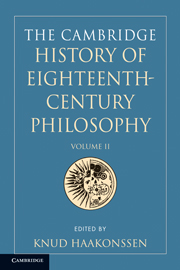28 - Artifice and the Natural World: Mathematics, Logic, Technology
from IV - Natural Philosophy
Published online by Cambridge University Press: 28 March 2008
Summary
If Tahiti suggested to theorists comfortably at home in Europe thoughts of noble savages without clothes, those who paid for and went on voyages there were in pursuit of a quite opposite human ideal. Cook’s voyage to observe the transit of Venus in 1769 symbolises the eighteenth century’s commitment to numbers and accuracy, and its willingness to spend a lot of public money on acquiring them. The state supported the organisation of quantitative researches, employing surveyors and collecting statistics to compute its power. People volunteered to become more numerate; even those who did not had the numerical rationality of the metric system imposed on them. There was an increase of two orders of magnitude or so in the accuracy of measuring instruments and the known values of physical constants. The graphical display of quantitative information made it more readily available and comprehensible. On the research front, mathematics continued its advance, even if with notably less speed than in the two adjoining centuries. The methods of the calculus proved successful in more and more problems in mechanics, both celestial and terrestrial. Elasticity and fluid dynamics became mathematically tractable for the first time. The central limit theorem brought many chance phenomena within the purview of reason. These successes proved of interest for ‘low philosophy’, or philosophy-as-propaganda, as practised by the natural theologians and the Encyclopedistes. Both had their uses for scientific breakthroughs, though sometimes not much interest in the details. For ‘high philosophy’, as constituted by the great names, mathematics and science had a different importance.
- Type
- Chapter
- Information
- The Cambridge History of Eighteenth-Century Philosophy , pp. 815 - 853Publisher: Cambridge University PressPrint publication year: 2000



